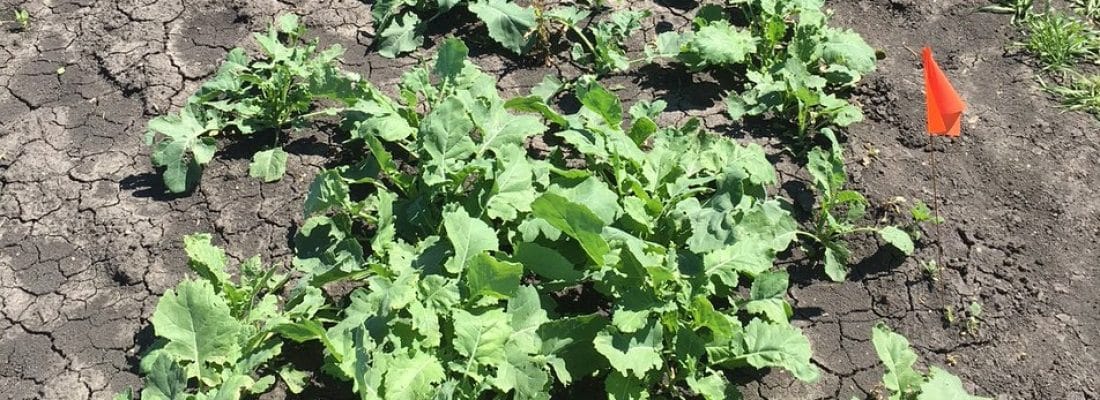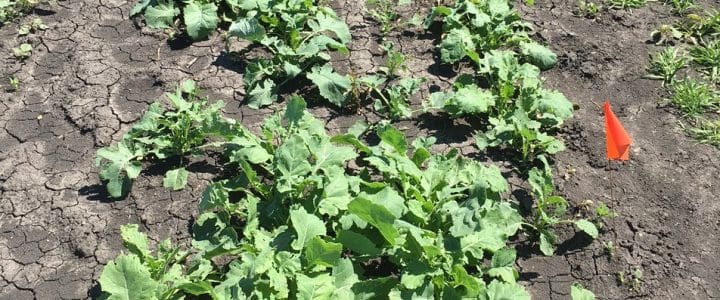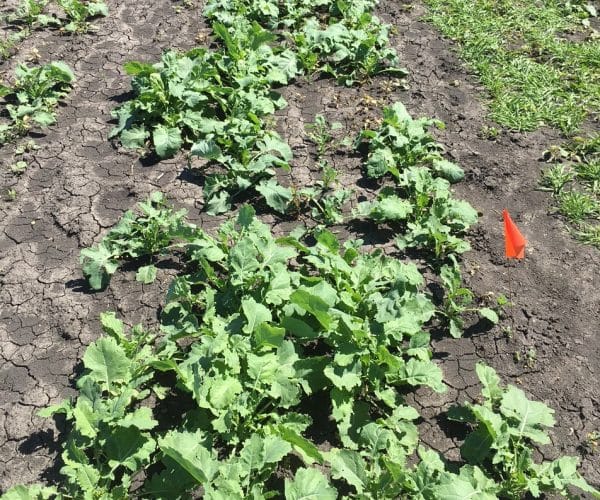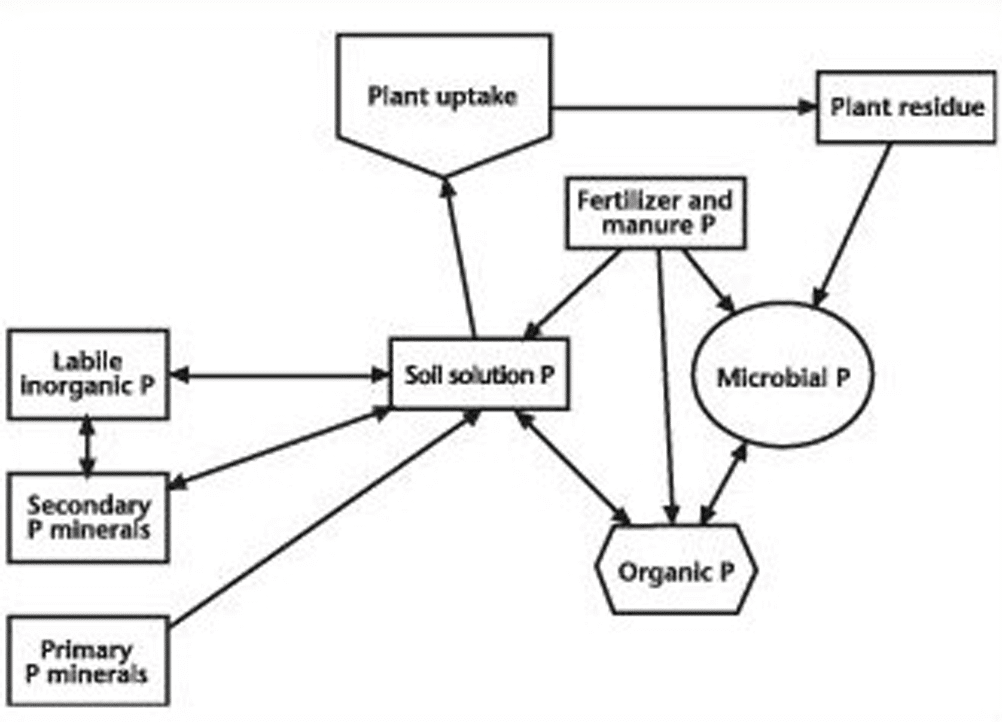- 1 Important tips for phosphorous fertility management
- 2 Role of phosphorus in canola plants
- 3 Phosphorus uptake by canola
- 4 Phosphorus cycle
- 5 Canola response to fertilizer phosphorus
- 6 Fate of applied fertilizer
- 7 Identifying deficiency symptoms
- 8 Placement of fertilizer
- 9 Application timing
- 10 Product choices
- 11 Footnotes
Phosphorus, although an important plant macronutrient, is only required in small amounts compared to nitrogen. Many Western Canadian soils are commonly phosphorus deficient and fertilization usually increases yield and economic returns. Good phosphorus fertilizer management is important for optimizing canola production.
Important tips for phosphorous fertility management
- Canola will respond well to starter phosphorus on low phosphorus soils. A “low” phosphorus level is a reading of 10 ppm or less in an Olsen (“bicarb”) test or 17 ppm or less in a Modified Kelowna test.
- Seed row placement is best for the first 15 to 20 pounds per acre, which is the amount most likely to produce an economic return in the year of application, due to the limited mobility of phosphorus and the importance of early uptake.
- Canola removes 0.9 to one pound of phosphorus from the soil for each bushel of canola seed yield. This exceeds the amount that can be safely seed-placed, and exceeds the rate that many growers apply. Therefore, soils will become depleted over time unless growers are consciously building soil phosphorus levels through higher application rates in other rotation crops.
Role of phosphorus in canola plants
The function of phosphorus in plants is as a structural element and in energy transfer. Structural components that rely on phosphorus include nucleic acids (the building blocks of DNA) and phospholipids (fats and oils), which are important membrane constituents.
Phosphorus plays a significant role in energy transfer in all living organisms. The phosphorus energy transfer compounds are phosphate esters. About 50 different esters have been identified so far. Adenosine triphosphate, or ATP as it usually referred to, is the principal phosphate energy compound used for starch synthesis and nutrient uptake. Energy produced during respiration and photosynthesis is captured by these phosphate compounds, which are then transported to areas that are building plant tissue. The energy stored in the phosphate compound is then released, and the molecule is recycled back to be ‘recharged.’ This recycling of phosphate energy compounds is accomplished at extremely fast rates, and a small amount can satisfy the plant’s energy needs.
Phosphorus uptake by canola
The main forms of phosphorus taken up by roots from the soil solution are primary and secondary phosphate ions (H2PO4– and HPO4-2). These phosphate anions exist transiently in the soil solution due to rapid removal by roots and microbes, or reactions with other soil minerals. The phosphorus level is highest in the canola seed and young vegetative material.
Canola seedlings take up phosphorus rapidly (and daily) during early growth (in the vegetative stage), but not as rapidly as nitrogen. Phosphorus uptake in early canola growth stages is more rapid than oats, flax and soybeans. Phosphorus levels remain fairly high in the leaves (0.3 to 0.4 per cent) until late flowering, when significant translocation to developing pods and seeds occurs. By maturity, 75 to 80 per cent of the phosphorus in above-ground dry matter is in the seed. Canola seed contains 0.7 to 0.8 per cent phosphorus, which is nearly double that of cereal grains. Canola stems and pods contain only 0.1 to 0.2 per cent phosphorus at harvest.
Canola is an efficient scavenger of soil phosphorus even though Brassica species are non-mycorrhizal. Many cereal crops can form these beneficial relationships with mycorrhizaeGenerally symbiotic associations between certain soil fungi and plant roots where the fungi contribute to the phosphorus nutrition of the plant and the plant provides photosynthates (energy source) to the fungus. More.
In spite of canola being non-mycorrhizal, research has shown that canola takes up more phosphorus than cereals. Canola has several mechanisms to achieve this efficient phosphorus uptake. Canola has abundant fine roots with the ability to branch and proliferate in zones of higher nutrient content, such as around fertilizer bands or granules. In addition, canola roots can increase the number and length of root hairs in response to low phosphorus conditions.
Canola roots also enhance phosphorus uptake with the solubilization of relatively insoluble mineral phosphorus forms. Canola has the ability to acidify the rhizosphere just behind the root tip, near the zone of root hair formation. In a growth chamber experiment, the pH of the canola rhizosphere fell up to 0.8 units over five weeks compared to a drop of less than 0.4 units for wheat rhizosphere. Canola absorbed more of the relatively insoluble phosphorus forms than wheat. The acid generated by canola roots is predominantly caused by exudation of organic acids such as malic and citric acid. Canola roots also release enzymes (phosphatases) that mineralize phosphate from organic phosphorus pools. Cation-anion uptake imbalance may also contribute to rhizosphere acidification when the main form of nitrogen uptake is ammonium. However, under western Canadian field conditions, canola takes up the majority of nitrogen in the nitrate form.
After phosphate enters the root, there are three barriers to cross before reaching the xylem system that feeds aboveground growth. These barriers are the cell plasma membrane, vacuole membrane and the xylem ‘loading’ site. The rate of phosphate transport across these membranes is affected by the plant’s phosphorus status. As the plant’s phosphorus content increases, the phosphorus transport rate decreases (feedback regulation). The phosphorus uptake rate is often more related to shoot than to root phosphorus level. This regulated transport system requires energy. Factors that influence root respiration will affect root phosphorus uptake. For example, cold soil or low oxygen content in a saturated soil reduces root respiration and consequently phosphorus uptake. There is competition for the phosphate transport system by arsenate. This can impact phosphorus nutrition in soils high in arsenate.
The xylem loading system is usually regulated separately from the systems at the plasma and vacuole membranes. Phosphate ions typically are rapidly transported from the roots to the shoots. Unlike nitrogen, phosphorus is absorbed and transported throughout the plant in the inorganic form (mainly H2PO4). Similar to nitrogen, phosphate is readily remobilized from aging tissue such as leaves to more active growing points. Phosphate stored in cell vacuoles can also be readily mobilized. Immature plants adequately supplied with phosphorus have 85 to 95 per cent of the total inorganic phosphate stored in the vacuoles. In contrast, in phosphorus deficient plants, almost all the phosphate in leaves is found in active pools (cytoplasm and chloroplasts). By maturity, most of the plant phosphorus is stored in organic forms, such as phytate, in the grain. Phytate serves as a readily accessible phosphorus source for the germinating seedling. Animal nutritionists are interested in seed phytate (including canola meal), since these compounds interfere with absorption of minerals such as zinc, iron and calcium. Considerable attention has been given to reducing phytate levels in grains, including canola, and some success is being reported.
Phosphorus cycle
Prairie soils contain significant amounts of total phosphorus (180 to 907 kilograms per acre or 400 to 2,000 pounds per acre). However, most of this soil phosphorus is relatively insoluble with limited availability to plants. Canola roots obtain phosphorus by absorbing phosphate dissolved in the soil water. Since the amount of phosphate dissolved in the soil water is very small at any given moment, there must be constant replenishment into the soil water from the insoluble forms. This replenishment of soil solution phosphorus around roots arises from slightly soluble minerals, phosphorus desorption from surfaces, organic phosphorus mineralization and fertilizer.
Both organic and inorganic phosphorus forms occur in soil, and both are important sources of plant available phosphate in soil water (soil solution phosphorus). Primary and secondary phosphate ions (H2PO4– and H2PO4-2) can be present in soil solution, with H2PO4– being the major form at pH up to 7.2. This solution phosphorus has several possible fates. It may be absorbed by roots, adsorbed to mineral surfaces, precipitated with various cations (such as calcium, Ca+2) or immobilized into microbial biomass and soil organic matter.
Soil phosphate supply is usually highest in the pH range of 6.5 to 7.0. At high pH levels (greater than 7.5), calcium and magnesium cations can precipitate with phosphate to form salts with low solubility. In contrast, in acidic soils (pH up to 6), iron and aluminum cations react with the phosphate to form insoluble compounds. Phosphate is not a mobile nutrient in soil due to these soil constituent reactions.
The natural soil weathering process causes acidification and this encourages the eventual conversion of primary phosphorus to secondary minerals and unavailable forms (occluded phosphorus). This transformation to unavailable forms takes centuries.
As phosphate is removed from the soil solution, the lower level stimulates phosphate release from exchangeable and labile inorganic pools. As labile pools are depleted, non-labile secondary phosphorus minerals slowly dissolve to maintain the labile and solution pools.
The organic phosphorus pool also contributes to the maintenance of phosphate in the soil solution. Organic phosphorus in prairie surface soil constitutes about 25 to 55 per cent of total phosphorus and is a large pool of potential plant available phosphorus. Microbial processes drive the organic section of the phosphorus cycle. Phosphate from organic matter can be released through decomposition and then incorporated into new microbial biomass or enter into the soil solution. Most organic phosphorus compounds released during decomposition are quickly degraded and exist briefly in soil. Some organic phosphorus compounds can be stabilized in soil through adsorptionThe process of electrical attraction that holds cations to negative surfaces of soil colloids. More to soil constituents or by physical isolation within aggregates. Tillage decreases the soil organic phosphorus content by breaking down soil aggregates and exposing stabilized forms to new or more vigorous microbial attack. Organic phosphorus can be degraded to phosphate by enzymes (phosphatases) released by soil microbes and by canola roots.
Canola response to fertilizer phosphorus
Canola will respond well to starter phosphorus on low phosphorus soils. A “low” phosphorus level is a reading of 10 ppm or less in an Olsen (“bicarb”) test or 17 ppm or less in a Modified Kelowna test.
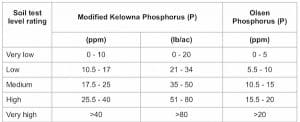
Seed row placement is best for the first 15 to 20 pounds per acre, which is the amount most likely to produce an economic return in the year of application, due to the limited mobility of phosphorus and the importance of early uptake.Canola removes 0.9 to one pound of phosphorus from the soil for each bushel of canola seed yield. This exceeds the amount that can be safely seed-placed, and exceeds the rate that many growers apply. Therefore, soils will become depleted over time unless growers are consciously building soil phosphorus levels through higher application rates in other rotation crops.
Yield
Without an adequate phosphorus supply, crop yield will be reduced. But while most agricultural soils in Canada have inadequate phosphorus for producing canola crops, and canola is very good at recovering phosphorus from the soil and can make efficient use of soil phosphorus if soil phosphorus levels are moderate to high.
With early seeding dates recommended for canola, some starter phosphorus fertilizer (15 to 20 pounds per acre) placed in close proximity to the seed is warranted, even on soils with sufficient phosphorus for target yields. Canola response to phosphorus fertilizer depends mainly on the amount of plant available phosphorus in the soil but is also influenced by moisture and temperature. In cold soil, phosphorus availability and movement is reduced. Canola response to phosphorus fertilizer is greater under these conditions.
Quality
Phosphorus fertilization has negligible effects on canola quality. Experiments in western Canada have found that phosphorus fertilizer increased, decreased or did not affect oil content. Phosphorus fertilization has occasionally slightly increased canola protein content. A recent field experiment on two very deficient sites in Manitoba found that phosphorus fertilizer significantly increased both protein and oil content.
Phosphorus fertilization can hasten maturity of canola crops by one or two days, primarily through more rapid emergence and early seedling growth. This may be important in short growing seasons.
Economic
In the short term, the greatest economic response to phosphorus fertilizer will come from the first six to 10 pounds per acre or so of phosphorus fertilizer placed in the seed row. (Note that this rate is too low to provide a prill or droplet in close proximity to each seed.) Higher rates placed in a band will restore soil phosphorus levels, but will have limited economic benefit in the short term unless soil phosphorus levels are very low. Soil with up to 20 pounds per acre of soil test phosphorus is generally considered very low and 20 to 35 pounds per acre is considered low. Canola grown at these soil test levels is usually very responsive to phosphate fertilizer.
However, this is based on the modified Kelowna test for soil phosphorus. Manitoba government recommendations for phosphorus consider up to 10 pounds per acre to be very low and 10-20 pounds per acre to be low, but this is based on a sodium bicarbonate test (i.e. the bicarb method). Generally, the modified Kelowna methods works much better over a wide range of soil pH levels. The bicarb method is fine in the neutral to alkaline pH range, which is typical in Manitoba, but does not correlate well to crop response on lower pH soils.
Fate of applied fertilizer
Phosphorus is not very mobile in the soil, moving only one to two centimetres (less than one inch) from point of placement. It also binds with calcium, magnesium, aluminum and iron. Roots must intercept phosphorus since phosphorus will only move short distances to roots.
Significant seasonal fluctuations occur in both organic and inorganic phosphorus pools. However, reports conflict on the direction and magnitude of the fluctuations. For example, several experiments reported decreases in organic phosphorus during the summer growing season and gains over the winter, while another experiment measured major declines over the winter. Inorganic phosphorus (soil test extractable phosphorus) can also vary widely and inconsistently between fall and spring.
Identifying deficiency symptoms
Phosphorus deficiency symptoms may include:
- delayed maturity
- spindly plants
- older leaves showing symptoms first (due to phosphorus being mobile in the plant)
The visual symptoms of plant phosphorus deficiencies are not generally definitive nor pronounced enough in the field to be very diagnostic. These symptoms can be mistaken for symptoms of other stresses unless direct comparison of growth in adjacent phosphorus-fertilized and non-treated areas within the field is possible.
Canola plants suffering from strong phosphorus deficiency can experience slow leaf expansion, smaller and fewer leaves. However, deficiency symptoms do not appear until at least the second week of growth, since canola seedlings are able to obtain sufficient phosphorus from seed reserves for the first week of growth.
Phosphorus deficient leaves may have a dark green or a bluish green colour since chlorophyll and protein formation are less affected than cell and leaf expansion. Under severe phosphorus deficiency, purple colouration can arise from accumulation of anthocyanin pigments (although this stress response can have many causes). Mildly deficient plants may look normal but small. Above-ground plant phosphorus content at flowering should be above 0.24 per cent.
Root growth is less affected by phosphorus deficiency than shoot growth, leading to a typical decrease in the shoot-root ratio. With a more severe deficiency, root development is restricted, but not as dramatically as stem and leaf growth. Although overall root branching is restricted in phosphorus deficient soils, root hair length and density usually increase.
Phosphorus deficiency affects the maturity and development of reproductive tissue. Even a mild phosphorus deficiency can result in maturity delays of several days compared to plants with adequate phosphorus. In addition to a flowering delay, phosphorus deficiency can reduce the number of flowers and seeds per pod. Also, a phosphorus deficiency can cause leaves to die and drop early, which contributes to the overall yield loss.
Proper diagnosis of nutrient deficiency should use most of the following tools:
- Soil test. Consider if any obvious shortages are evident? Other soil test parameters such as texture, pH and electrical conductivity and compaction may also provide clues in the diagnosis.
- Fertilizer history. What rates and source products have been applied on that field, in past years? Include crop yields and consider whether rates have been adequate to match removal.
- Tissue test. Do not use this alone. Follow sample guidelines provided by the lab. Also keep in mind that nutrients may be in the soil at adequate rates, but due to cold or some other stress, the plant simply can’t access them. In the case of cold or excess moisture, plants may recover on their own when soils warm up or dry out again. Plants stressed by other factors may show elevated content of some nutrients due to concentration effects. When tissue testing, compare healthy areas to poor areas of the field and look for differences.
- Herbicide history. Is there any chance of carryover from products applied one or two years ago? In dry conditions or very wet conditions, herbicides can take longer than expected to break down to safe recropping levels for canola and either restrict root growth or cause symptoms that could be mistaken for nutrient deficiencies.
- Environment. Cold, wet, hot and dry can all stress canola plants, creating symptoms that may look like nutrient deficiencies. If neighbors have similar symptoms, the cause is more likely environmental (e.g. frost, excess moisture, etc.).
- History of the land. Recently broken forage land is likely to be depleted in a lot of nutrients. Canola seeded into a field that was in long-term alfalfa, for example, is one case where severe crop stunting and delayed maturity may occur as a result of a phosphorus deficiency. Otherwise it is rare to see severe phosphorus deficiency in canola.
- Look at other fields for similar symptoms. When diagnosing for a specific nutrient, target the crop that tends to be most sensitive to that nutrient.
Placement of fertilizer
The majority of phosphorus fertilizer is not absorbed by canola in the application year. Instead, most of the fertilizer phosphorus reacts with soil constituents to form relatively insoluble salts or stabilized phosphorus compounds. Proper timing and placement will maximize phosphorus fertilizer uptake and yield response.
Research comparisons of phosphorus fertilizer placement methods at typical rates show that highest yields are frequently obtained with seed-placed and split applications, followed closely by pre-plant band methods. Broadcast-incorporated methods produce significantly lower yield responses in the year of application.
Seed row
Phosphorus supply during the first two to six weeks of canola growth is critical to achieve optimal yield. Given that soil supply is reduced under wet, cold conditions, canola benefits from a seed-placed supply of fertilizer phosphorus. Cold soil decreases phosphate solubility and diffusion in the soil solution, slowing phosphorus movement to roots and root uptake rates. This condition increases the likelihood of response to readily accessible seed row phosphorus.
A seed-placed application of 15 to 20 pounds per acre will ensure that each canola seed has a phosphate prill or droplet in close enough proximity to access some phosphorus readily, since phosphorus is not very mobile in the soil. This is assuming that the seed and fertilizer is being placed in a relatively narrow band. Reducing the seed-placed rate below that level may restrict availability, especially if combined with a wider spread width of the seed and fertilizer band.
The maximum safe rate of seed row phosphorus fertilizer for canola depends on seedbed utilization and soil moisture conditions. Under dry soil conditions with low seedbed utilization (such as disc opener), the maximum safe phosphate fertilizer (P2O5) seed-placed rate is approximately 22 kilograms per hectare (20 pounds per acre). The rate can be safely increased to 28 kilograms per hectare (25 pounds per acre) under good moisture conditions with low seedbed utilization.
As seedbed utilization increases, growers can proportionally increase seed-placed phosphorus fertilizer rates. This may be necessary because the greater the seedbed utilization, the wider apart the granules are spaced. Higher rates will ensure that phosphorus prillsSmall, round pellets of dry fertilizer. More or droplets maintain close proximity to each seed.
Safe rates are dictated by the nitrogen component of phosphorus fertilizers. Toxicity is mainly related to salt effect from nitrogen portion of monoammonium phosphate (MAP) fertilizer. Canola has low tolerance to seed placed nitrogen. The ammonium component of MAP is all the nitrogen a canola plants needs to generate a root system to reach nitrogen in a side band or other placement choice.
If the target phosphorus rate is too high for safe placement in the seed row, a split application (some in the seed row, some in the band) is one option. If a split is not possible, Saskatchewan research showed that placing all phosphorus in the side band could be better for stand establishment and yield than placing it all in the seed row. 1
Banding
Pre-plant band reduces fertilizer contact with sensitive canola seeds and with soil constituents that will fix phosphorus, making it less available over time. Also, the deeper fertilizer placement tends to be more accessible to roots as they normally grow down to moist soil. Banding fertilizer prior to seeding reduces the fertilizer handled during seeding and can provide time and labour benefits. Phosphorus fertilizer can be banded in late fall or spring prior to seeding. Given that canola benefits from early-season access to phosphorus fertilizer, some phosphorus should be placed in the seed row as well, especially if the soil phosphorus availability is low enough that the full fertilizer phosphorus requirement cannot be safely seed-placed.
Dual banding is another option. At low to moderate rates of nitrogen, the uptake efficiency of phosphorus is sometimes increased from a dual band. At nitrogen rates above 90 kilograms per hectare (80 pounds per acre) the concentrated nitrogen in the band can reduce early season phosphorus uptake due to ammonia and nitrite toxicity that hinders root entry into the band. This phosphorus uptake interference appears to be strongest in recent band applications, and could be a problem with dual spring banded nitrogen and phosphorus fertilizer applied immediately before or during seeding.
Side-banding places fertilizer near the seed row during seeding. The fertilizer normally is banded 2.5 to five centimetres (one to two inches) below and beside the seed row. Several direct seedingA seeding method where the crop is sown into the field without any previous spring tillage operations. More machines use a mid-row or paired-row method of banding fertilizer. Air seeders with shovels or knives are used with shank spacings ranging from 20-36 centimetres (eight to 14 inches). The fertilizer is usually banded to a depth of five to 13 centimetres (two to five inches). No consistent agronomic benefits accrue to banding deeper than eight centimetres (three inches) and fuel costs increase significantly with deeper depths. In high phosphorus-fixing soils, place fall phosphorus bands deeper than subsequent tillage depths to avoid mixing the band with soil. Since phosphorus is fairly immobile in the soil, it will take more time for young canola roots to reach the band than it would take to reach fertilizer placed in the seed row.
Split applications combine band and seed row placement. This takes advantage of the consistent benefit of seed-placed phosphorus fertilizer up to 22 kilograms (of P2O5) per hectare (20 pounds per acre) and avoids seedling injury by placing the remainder of the phosphorus fertilizer in a band (usually with nitrogen and sulphur).
Broadcast
Broadcast-incorporated placement involves spreading phosphorus fertilizer on the surface followed by cultivating the field to work it into the soil. This method is significantly less effective than seed-placed or banded phosphorus fertilizer due to increased contact between the phosphorus and reactive soil constituents. Application rates with broadcast-incorporated phosphorus fertilizer usually have to be two to four times the seed-placed or banded rates in order to get an equal response. Therefore, broadcast-incorporated methods are less economical at low rates.
Broadcast without incorporation leaves phosphorus, which is immobile in the soil, on the soil surface. Canola uptake will be very low. Broadcast without incorporation is only recommended for established forage crops because alfalfa and grasses have feeder roots very near the soil surface.
In-crop
Phosphorus needs to be in place early, and because it is relatively immobile in the soil, it works best when placed in the root zone. Otherwise roots may take a while to find phosphorus for uptake. For these reasons, in-season top up applications have limited success in addressing a phosphorus deficiency in the season of application. A top up isn’t a complete loss if there isn’t a response in the year of application, as any unused phosphate will remain in the soil and be available to future crops. This should not, however, change your fertilizer plans for the following year, as top up rates tend to be quite low and seed-placed phosphorus will remain a worthwhile practice. Foliar applications may help in severe phosphorus deficiencies, but the amount of phosphorus applied is much less than the crop will ultimately need, so the foliar application are a poor substitute for banded phosphorus applications.
4R Practices for spring cereal, oilseed, and pulse rotations in the Canadian Prairies without manure or compost – Prairie and Boreal plains ecozones
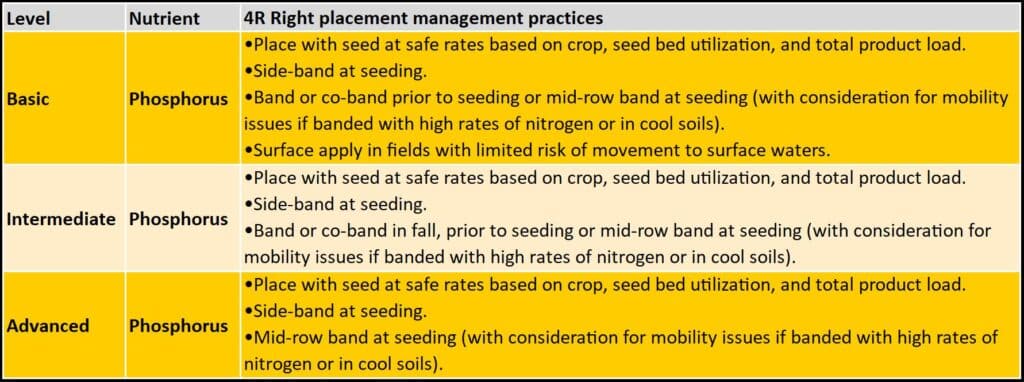
Application timing
Since phosphate reacts with soil constituents to form insoluble compounds over time, phosphorus fertilizer efficiency may be increased with a spring application, which limits the time between application date and crop uptake. However, the phosphorus fertilizer application date affects canola yield much less than placement method. Phosphorus fertilizer applied in the seed row at seeding minimizes phosphorus availability losses by reducing reaction time. Western Canadian research has shown the effectiveness of fall and spring banding of phosphorus fertilizer is similar.
Product choices
Plants need a given amount of phosphorus to yield accordingly, regardless of the form that is applied.
Available forms
Monoammonium phosphate (MAP, which is either a 11-52-0 or 12-51-0 nitrogen-phosphorus-potassium blend) is the standard dry fertilizer source for the Prairies. Ammonium in the formulation enhances efficiency and phosphorus is in the orthophosphate form. Diammonium phosphate (DAP, which is a 18-46-0 nitrogen-phosphorus-potassium blend) is also available.
Ammonium polyphosphate (APP, which is a 10-34-0 nitrogen-phosphorus-potassium blend) is the standard liquid phosphorus fertilizer source. With this formulation, phosphorus is in both orthophosphate and polyphosphate forms. Polyphosphate is a chain of orthophosphate molecules, which converts readily into orthophosphate through reaction with soil moisture.
Whether phosphorus fertilizer is liquid or granular does not affect the utilization by plants. Liquid sources of phosphorus are not more available than granular sources, even in a dry year. The selection of a liquid or granular phosphorus source should be based on the farmer’s operation, convenience and economics. Liquid may allow for better distribution and metering of the product, while granular may have cost advantages.
Manure can be a very good source of phosphorus (and nitrogen) but manure should be tested for nutrient content per tonne before setting application rates per hectare (or acre). Manure contains a combination of inorganic and organic phosphorus. Most of the inorganic phosphorus is the orthophosphate form. Organic phosphorus has to be mineralized before plants can take it up. Approximately 60-80 per cent of the total phosphorus in manure is available to crops in the first year.
Special formulations
Fluid orthophosphates (such as Alpine) have phosphorus in the orthophosphate form entirely, which is the form that plants take up. Liquid APP has a mix of polyphosphate and orthophosphate, usually in about equal parts. Field performance differences between orthophosphate and polyphosphate sources are minimal, since polyphosphate converts to orthophosphate in soils rapidly, with half usually converted within a week. Conversion may be slower if soils are cool and dry.
Avail, an additive for granular or liquid phosphorus fertilizer, claims to keep phosphate fertilizer in a plant available form for longer. Canola experiments in Manitoba reported higher yields in one year and one soil type (fine sandy loam) with high rates of Avail-treated MAP compared to high rates of controlled-release phosphate or uncoated MAP. Otherwise (both in this study and others across the Prairies) results have been inconclusive, often because any yield response to phosphorus fertilizer is so variable.
Rock phosphate is the relatively insoluble, gray-black powdery material that is refined into soluble phosphate fertilizer. High rates of rock phosphate slightly improve canola yields on some soils, but it is not cost effective compared to fertilizer phosphate. Typically, rock phosphate application rates need to be six to eight times that of fertilizer phosphate for equivalent yield response. Alberta Agriculture Food and Rural Development research illustrated the poor performance of rock phosphate compared to fertilizer phosphorus.
Polymer-coated phosphate fertilizer is a potential option. Polymer coating will control the release of fertilizer into the soil. This can increase the safety of very high rates of seed-placed MAP, but high rates of seed-placed MAP are not needed for crops to reach their yield potential. A Western Canadian study found that, in general, a rate of 30 kg P2O5 ha (roughly 30 pounds per acre) was sufficient to produce maximum early season biomass yield and phosphorus uptake for both conventional MAP and controlled release phosphate (CRP) fertilizers. Large differences in early phosphorus availability were not evident between the conventional phosphorus and controlled released phosphorus fertilizer products.
Inoculants
Penicillium bilaii (which can be applied to seed using the product Jumpstart) is a fungus that mobilizes phosphorus in rhizosphere (root zone), making it more available to the crop. Research in wheat has shown inconsistent results, with some positive results and some negative results. Canola is better than wheat at extracting phosphorus from the soil all on its own, and is less likely to benefit from soil treatments such as P.bilaii.
Footnotes
- Pratchler, J., Brandt, S. 2016-18. Enhancing canola production with improved phosphorus fertilizer management. Canola Research Hub[↩]
